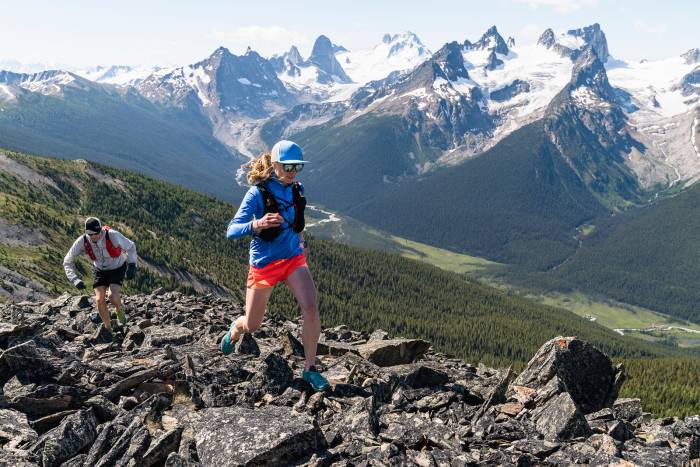Last month, in the early-spring woods of Black River State Forest in central Wisconsin, I suited up at 10a.m. and with a partner ran about 22 miles up and down hills, through trees, across a swamp, and down about 15 miles of trails. It was an epic day, a 5+ hour run that felt harder than a marathon. The venue was the Badger Rogaine Race, a long-distance orienteering event on April 2nd for which my race partner, Andrei Karpoff, and I had trained on and off for months.
The niche activity of “wilderness running,” which is most often seen in orienteering and adventure racing events, is something I’ve come to hold as my athletic calling card. The combination of bushwhacking and wilderness navigation mixed with stints of trail running suits my aerobic-oriented personality and fulfills the requisite “adventure quotient” I need when getting out. At the Badger event last month, Karpoff and I took first place, edging out a dozen other squads. We finished muddy and tired, with wet feet and sore legs. But we were happy with our finish after a tough day.

For anyone motivated to try it, below are a few tips I’ve learned in the field. These points apply most to orienteering, rogaining (an offshoot sport of orienteering), and adventure racing — though don’t be afraid to bank the knowledge for alpine climbs with long approaches, ultralight backpacking, and other fast-and-light pursuits. Or, if you’re like me, you will get outside and into the mountains or woods to train and go fast on difficult “wilderness run” adventures just for fun. Here are five quick tips:
1. Get Your Feet Wet — The short story is. . . in the woods and off-trail, your feet are bound to get wet. Learn to live with it. In wilderness running, your feet are often wet much of the time, with snow, swamps, trail puddles, or stream crossings soaking over your shoes sometimes within the first minutes of a race or training session. My solution? I use Hydropel or other foot lubes to avoid chafing and to keep my feet from soaking in too much water. (“Pruney” feet are bad, as blisters can easily bloom when your feet get wrinkly.) I wear lightweight shoes that drain water and do not retain moisture in the uppers. Waterproof shoes like Gore-Tex trail runners rarely work in the anarchy of a wilderness run. Feet find a way to get wet, it’s almost a rule.
2. Vegetative Barriers — Almost nothing slows a runner more than thick vegetation. On a choose-your-own-adventure course where you follow a map to checkpoints or across geographic features try and read the land and follow the least-thick areas. Stay on high ground. Advice? Look for ridgelines and animal trails. Avoid river bottoms. Swamps? Avoid at all costs. Best practices for any particular area will require specific knowledge of area topography and its flora. Know the land before you run or race if you can, or at least take a fast lesson learning along the way.

3. Navigation — People write books on wilderness navigation and orienteering. But the big picture is this: Understand your map, and understand — at all times! — where you are on that map. Don’t run blindly into a valley thinking you’ll figure it out along the way. Look for big topographic features to guide you. Use “backstops,” like a river that you’ll eventually hit if your trajectory is west, as example. I put my thumb on the map as a place marker to where I am. I move my thumb along the route as I run, glancing quick every so often to the page to move my thumb and reconfirm my place in the land.
4. Eat! — Caloric requirements increase in the woods. You’re no longer running on a road or smooth trail. Wilderness can demand full-body participation, including climbing over logs, hopping talus, ascending cliffs, crawling in the underbrush when it gets too thick. . . . With all the extra output, your body needs more fuel. I stay hydrated and try to eat 200 to 300 calories an hour, including sweet and salty items. Energy gel can get you only so far.
5. Old Clothes — No activity on the planet is as hard on clothing as orienteering or wilderness runs. Thorns tear. Mud and sap stain. Swamp water seeps in. Your body sweats, and your clothes stink. You may swim, run, crawl, and climb in the clothes to traverse a piece of land. I often look like a hobo by the end of a race, shredded pants and a dirty shirt to match. All this is to say. . . wear old clothes, not your fancy new athletic tights, and bank on the durable side of apparel when you can. Axis Gear out of Canada and other orienteering clothing companies make clothing that stands up better than most. I often wear old tights I don’t care about shredding. Or I wear nylon pants from Rail Riders, which are stout trousers that are not the greatest for running, but at least they can stand up to the thorns.
—Stephen Regenold is founder and editor of www.gearjunkie.com. A version of this post ran originally on Gear Junkie’s blog on VentureThere.com, a USA Today property.








